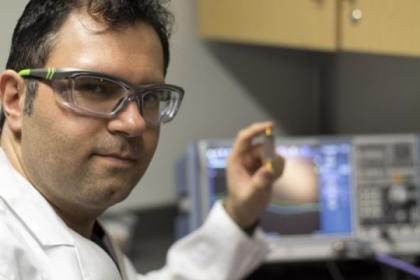- Home
- Editorial
- News
- Practice Guidelines
- Anesthesiology Guidelines
- Cancer Guidelines
- Cardiac Sciences Guidelines
- Critical Care Guidelines
- Dentistry Guidelines
- Dermatology Guidelines
- Diabetes and Endo Guidelines
- Diagnostics Guidelines
- ENT Guidelines
- Featured Practice Guidelines
- Gastroenterology Guidelines
- Geriatrics Guidelines
- Medicine Guidelines
- Nephrology Guidelines
- Neurosciences Guidelines
- Obs and Gynae Guidelines
- Ophthalmology Guidelines
- Orthopaedics Guidelines
- Paediatrics Guidelines
- Psychiatry Guidelines
- Pulmonology Guidelines
- Radiology Guidelines
- Surgery Guidelines
- Urology Guidelines
New tool developed for instant diagnosis of bacterial infection

The researchers at UBC Okanagan, in collaboration with the University of Calgary, have built a diagnostic tool using a small and inexpensive biosensor. The tool provides health care practitioners almost instant diagnosis of a bacterial infection. It provides reliable and accurate results in real-time that makes it more spontaneous than the existing process that takes two-to-five days in providing diagnosis results for testing infections and antibiotic susceptibility.
Mohammad Zarifi, an assistant professor at UBC Okanagan, and colleagues tested their device by tracking the amount of bacteria present in a variety of samples under various scenarios. The scenarios resembled those encountered in clinical microbiological laboratories.
"Advances in lab-on-a-chip microfluidic technology are allowing us to build smaller and more intricate devices that, in the medical research space, can provide more information for health care practitioners while requiring less invasive sampling from patients," explains Zarifi.

Mohammad Zarifi shows his small biosensor that can be used to provide a real-time diagnosis of a bacterial infection.
By sending a microwave signal through the sample, the device quickly and accurately analyzes and then generates a profile of existing bacteria.
According to Zarifi, the diagnostic tool not only provides a rapid, label-free and contactless diagnostic tool for clinical analysis but it also goes further.
"The device is able to rapidly detect bacteria and in addition, it screens the interaction of that bacteria with antibiotics," he adds. "The combined results give health care practitioners more information than they currently have available, helping them move forward to determine accurate treatments."
"This biosensor is a significant step forward in improving the complex antibiotic susceptibility testing workflow and provides a rapid and automated detection of bacteria as well as screening the bacteria proliferation in response to antibiotics," explains Zarifi.
For further reference follow the link: https://doi.org/10.1038/s41598-018-34001-w

Disclaimer: This site is primarily intended for healthcare professionals. Any content/information on this website does not replace the advice of medical and/or health professionals and should not be construed as medical/diagnostic advice/endorsement or prescription. Use of this site is subject to our terms of use, privacy policy, advertisement policy. © 2020 Minerva Medical Treatment Pvt Ltd